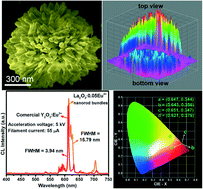La(OH)3:Eu3+ and La2O3:Eu3+ nanorod bundles: growth mechanism and luminescence properties†
Abstract
Oriented attachment assisted self-assembled three-dimensional (3D) flower-like La(OH)3:Eu3+ nanorod bundles were successfully synthesized by a facile wet-chemical method. Hexamethylenetetramine played an important role in the formation of the hexagonal phase of La(OH)3:Eu3+ with respect to the reaction time and its concentration. No other surfactants or capping agents were used. The calcination temperature did not show any influence on the morphological texture, and the La2O3:Eu3+ phase was obtained by a subsequent annealing process. The phase formation and morphological properties were confirmed by X-ray diffraction, scanning electron microscopy, and transmission electron microscopy. The photoluminescence properties were studied for both the synthesized La(OH)3:Eu3+ and La2O3:Eu3+ samples, and also compared with that of the solid-state reaction based La2O3:Eu3+ phosphor. The 3D flower-like La2O3:Eu3+ nanorod bundles showed an intense red emission due to the hypersensitive 5D0 → 7F2 transition with good asymmetric ratio and chromaticity coordinates. Likewise, a systematic study of the cathodoluminescence (CL) properties was carried out in detail. Furthermore, to estimate the CL potentiality, the La2O3:Eu3+ phosphor was compared with a commercially available Y2O3:Eu3+ red phosphor.



 Please wait while we load your content...
Please wait while we load your content...